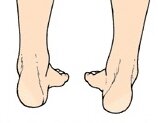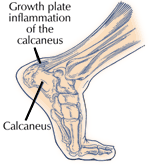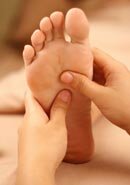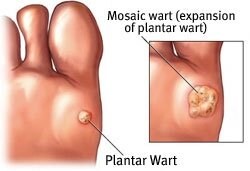Supination is a turning inward of the foot at the ankle, so that one has a tendency to walk on the outer border of the foot.
OurHealthNetwork Articles
Flat Feet
The normal arch functions as a shock absorber for our entire body. Each time we step down, we place up to 5 times our body weight on the foot, depending on whether we are walking, running, or jumping. If there were no shock absorber in the foot, the force of each step would eventually fracture or dislocate the bones of the foot, leg, and lower back. When the arch is flat (a flat foot), it cannot function properly. If left untreated, this will lead to a completely collapsed foot which cannot function as a shock absorber at all; and, this in turn can cause constant pain in the foot, and eventually the knee, hip, and lower back.
Supination
Description
|
|
|
Chief Diagnostic Sign: You can test for supination by looking at the leg and foot from the back. Normally you can see the Achilles tendon run straight down the leg into the heel. If the foot is supinated, the tendon will run straight down the leg, but when it lies on the heel it will twist inward. This makes the outer ankle bone appear more prominent than the inner ankle bone.
Because supination is a twisting of the foot, all of the muscles and tendons that run from the leg and ankle into the foot will be twisted. If left untreated, supination may be the cause of heel spurs, plantar fasciitis, hallux limitus and rigidus, ball of foot pain (metatarsalgia), shin splints, high and painful arches, and eventually knee, hip, and lower back pain. Supination can also predispose to ankle sprains due to the excess stress applied to the lateral ankle tendons and ligaments.
Pronation
Description
Pronation is a turning outward of the foot at the ankle, so that one has a tendency to walk on the inner border of the foot. (Pronation is the opposite of supination). When a foot and ankle pronates to a great degree, we call it over-pronation. During the normal gait cycle, we all pronate and then rapidly recover. It is over-pronation 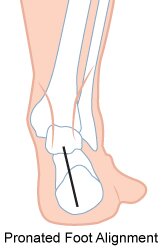 that patients are concerned with. This is a static deformity associated with flat feet and sometimes with foot and arch pain.
that patients are concerned with. This is a static deformity associated with flat feet and sometimes with foot and arch pain.
Chief Diagnostic Sign: You can test for pronation by looking at the leg and foot from the back. Normally you can see the Achilles Tendon run straight down the leg into the heel. If the foot is pronated, the tendon will run straight down the leg, but when it lies on the heel it will twist outward. This makes the inner ankle bone much more prominent than the outer ankle bone.
Because pronation is a twisting of the foot, all of the muscles and tendons that run from the leg and ankle into the foot will be twisted. If left untreated, pronation may be the cause of heel spurs, plantar fasciitis, frequent ankle sprains, shin splints, weak and painful arches, and eventually knee, hip, and lower back pain.
Help with drug costs
For many Medicare beneficiaries, prescription drug costs can be a significant financial burden. Fortunately, Medicare offers a program called "Extra Help" to assist those with limited income and resources. This blog post will explore the Extra Help program and other strategies to manage your Medicare drug costs effectively.
Medicare Costs
Medicare provides essential health coverage for millions of Americans, but understanding its cost structure can be daunting. This guide aims to demystify Medicare costs, helping you make informed decisions about your healthcare coverage.
Sever’s Disease (Children’s Heel Pain)
Description
|
When recurring heel pain occurs in children, it is usually due to Sever’s Disease, while adult heel pain is usually due to heel spurs, plantar fasciitis, or retrocalcaneal bursitis (Haglund’s Deformity). Definitions:
|
|
Tendonitis
Description
Tendonitis is an inflammation of a tendon caused by an injury. It is most often an overuse injury. Often people begin a new activity or exercise that causes the tendon to become irritated. Tendon problems are most common in the 40-60 year old age range. Tendons are not as elastic and forgiving as they might be in younger people. Occasionally, there is an anatomical cause for tendonitis. If the tendon does not have a smooth path to glide along, it will be more likely to become irritated and inflamed. In these unusual situations, surgical treatment may be necessary to realign the tendon.
Muscles end as tendons, and it is the tendons that allow muscles to attach to the bones or joints of the body. You can easily see tendons on the back of the hand, or top of the foot, by moving a finger or toe. The tendon moves back and forth as you move the finger or toe. Most of the tendons in the feet, especially those on the top, are very close to the skin and are not well protected. Thus, they can easily be injured.
Injuries that frequently cause tendonitis include:
Twisting injuries of the foot and ankle.
Dropping an object on the foot (it does not have to be a heavy object; all it has to do is hit the tendon directly).
Tight shoes.
Tying shoelaces too tightly.
High heel shoes (especially if you are not used to wearing them).
Overdoing any weight-bearing activity, such as running too far.
If there is a cut or break in the skin associated with a tendon injury, see a doctor immediately. Tendons have few blood vessels, and an open wound down to the tendon can cause a severe infection. Tendons usually have an area of poor blood supply that leads to tissue damage and poor healing response. This area of a tendon that is prone to injury is called a “watershed zone,” an area when the blood supply to the tendon is weakest. In these watershed zones, the body has a hard time delivering oxygen and nutrients necessary for tendon healing.
Tired, Achy Feet
Why do so many people complain of tired and achy feet and legs?
Description
The normal arch functions as a shock absorber for our entire body. Each time we step down we place up to 5 times our body weight on the foot, depending on whether we are walking, running, jumping, or carrying heavy loads. If the arch is either too low or high, it cannot function as efficiently as a shock absorber; thus, the soft tissues and bones of the absorb the pressure of each step. These structures are not designed to absorb these forces, and after a few hours they become “tired or achy.”
|
Biomechanical problems in the feet, such as pronation, may prevent the ligaments, tendons, and muscles from binding the joints together properly. This allows the joints to slip, the arch to collapse, and the bones to move into abnormal positions. When these actions occur, the feet can no longer act as an efficient support for the body. The results are feelings of fatigue and “achiness” which spreads to the legs and back. Loss of the protective fatty pads in the heels or balls of the feet can also lead to tired and achy feet and legs. These fatty pads act as cushions that absorb the tremendous forces that are applied to our feet with each step that we take. If these pads become too thin, or disappear all together, the bones and joints in the feet absorb these stresses instead. When this occurs, our feet become tired, “achy,” and eventually painful. This fatigue eventually travels to the leg muscles, causing them to ache. |
|
Carrying heavy loads, whether they are heavy trays of dishes or heavy pieces of equipment, will also place increased and abnormal forces and weight on our legs and feet. These forces and weight will eventually cause the body’s natural shock absorbers (the arches of the feet) to collapse, and our fatty cushions to be destroyed. As this occurs, our feet and legs become “tired,” producing aches and pains in the feet and legs.
Similarly, when we gain extra weight, our feet and legs do not become larger and stronger. Carrying extra weight will tire the feet and legs out quickly, causing “achy” and tired feelings. This may eventually lead to pain.
Standing in confined areas for long periods of time, or occupations that require redundant activity using legs and feet will cause fatigue.
Venous insufficiency can also cause a heavy feeling in the legs and fatigue. Even people without venous insufficiency can benefit and avoid tired, achy feet with the use of support socks and stockings. The gentle compression helps in eliminating the “tired feeling”.
Treatment
An effective method of relieving foot and leg fatigue and “achiness” is to use specially designed custom-made orthotics. Custom-made orthotics are made from molds of your feet, designed for your foot’s structure and problems, your life-style, and your shoes. Our custom-made orthotics will help to:
Re-establish the normal position of the joints in your feet, thus allowing your feet to function efficiently again, helping to alleviate fatigue and “achiness.”
Support the arch of the foot, allowing it to be the efficient shock absorber it was designed to be, when it is at its optimum height.
Using modern materials that mimic the body’s protective fatty pads, we once again maximize the shock absorption at the heels and balls of the feet. This will reduce the stresses and forces on the bones, joints, and muscles of the feet. The feet will feel younger, and foot and leg fatigue and pain will subside.
Warts
Description
A wart, or verruca, is a small bump on the skin caused by a virus that infects the top layer of skin cells. Warts are believed to be transmitted through direct or indirect contact (via a gym or shower floor) with a person carrying the virus. This virus, called human papilloma virus (HPV), is easier to “catch” if there is a cut or an abrasion on the skin. |
|
Plantar warts are non-cancerous skin growths that occur on the bottom of the feet. They frequently are studded with pinpoint dark spots, which are tiny, clotted blood vessels. When they occur on portions of the feet that bear weight, they are flattened by the weight placed on them, and can be quite painful. They can be confused with corns; however, corns lack surface pinpoint dark spots. Another diagnostic evaluation can be done manually; plantar warts or veruca are very painful upon lateral compression and less so on direct digital pressure. A deep seeded corn, keratosis, callous will be more painful on direct pressure.
